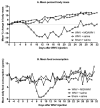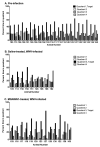Treatment of spatial memory impairment in hamsters infected with West Nile virus using a humanized monoclonal antibody MGAWN1
- PMID: 21554903
- PMCID: PMC3125166
- DOI: 10.1016/j.antiviral.2011.04.011
Treatment of spatial memory impairment in hamsters infected with West Nile virus using a humanized monoclonal antibody MGAWN1
Abstract
In addition to functional disorders of paresis, paralysis, and cardiopulmonary complications, subsets of West Nile virus (WNV) patients may also experience neurocognitive deficits and memory disturbances. A previous hamster study has also demonstrated spatial memory impairment using the Morris water maze (MWM) paradigm. The discovery of an efficacious therapeutic antibody MGAWN1 from pre-clinical rodent studies raises the possibility of preventing or treating WNV-induced memory deficits. In the current study, hamsters were treated intraperitoneally (i.p.) with 32 mg/kg of MGAWN1 at 4.5 days after subcutaneously (s.c.) challenging with WNV. As expected, MGAWN1 prevented mortality, weight loss, and improved food consumption of WNV-infected hamsters. The criteria for entry of surviving hamsters into the study were that they needed to have normal motor function (forelimb grip strength, beam walking) and normal spatial reference memory in the MWM probe task. Twenty-eight days after the acute phase of the disease had passed, MGAWN1- and saline-treated infected hamsters were again trained in the MWM. Spatial memory was evaluated 48 h after this training in which the hamsters searched for the location where a submerged escape platform had been positioned. Only 56% of infected hamsters treated with saline spent more time in the correct quadrant than the other three quadrants, as compared to 92% of MGAWN1-treated hamsters (P⩽0.05). Overall these studies support the possibility that WNV can cause spatial memory impairment and that therapeutic intervention may be considered.
Copyright © 2011 Elsevier B.V. All rights reserved.
Figures





Similar articles
-
Defining limits of treatment with humanized neutralizing monoclonal antibody for West Nile virus neurological infection in a hamster model.Antimicrob Agents Chemother. 2007 Jul;51(7):2396-402. doi: 10.1128/AAC.00147-07. Epub 2007 Apr 23. Antimicrob Agents Chemother. 2007. PMID: 17452485 Free PMC article.
-
Humanized monoclonal antibody against West Nile virus envelope protein administered after neuronal infection protects against lethal encephalitis in hamsters.J Infect Dis. 2006 Nov 1;194(9):1300-8. doi: 10.1086/508293. Epub 2006 Sep 22. J Infect Dis. 2006. PMID: 17041857
-
Safety and pharmacokinetics of single intravenous dose of MGAWN1, a novel monoclonal antibody to West Nile virus.Antimicrob Agents Chemother. 2010 Jun;54(6):2431-6. doi: 10.1128/AAC.01178-09. Epub 2010 Mar 29. Antimicrob Agents Chemother. 2010. PMID: 20350945 Free PMC article. Clinical Trial.
-
Neurological approaches for investigating West Nile virus disease and its treatment in rodents.Antiviral Res. 2013 Nov;100(2):535-45. doi: 10.1016/j.antiviral.2013.09.010. Epub 2013 Sep 19. Antiviral Res. 2013. PMID: 24055448 Free PMC article. Review.
-
West Nile virus neuroinvasive disease.Ann Neurol. 2006 Sep;60(3):286-300. doi: 10.1002/ana.20959. Ann Neurol. 2006. PMID: 16983682 Review.
Cited by
-
Respiratory insufficiency correlated strongly with mortality of rodents infected with West Nile virus.PLoS One. 2012;7(6):e38672. doi: 10.1371/journal.pone.0038672. Epub 2012 Jun 14. PLoS One. 2012. PMID: 22719920 Free PMC article.
-
Possible future monoclonal antibody (mAb)-based therapy against arbovirus infections.Biomed Res Int. 2013;2013:838491. doi: 10.1155/2013/838491. Epub 2013 Aug 22. Biomed Res Int. 2013. PMID: 24058915 Free PMC article. Review.
-
Clinical manifestations and outcomes of West Nile virus infection.Viruses. 2014 Feb 6;6(2):606-23. doi: 10.3390/v6020606. Viruses. 2014. PMID: 24509812 Free PMC article. Review.
-
Plasticity of a critical antigenic determinant in the West Nile virus NY99 envelope protein domain III.Virology. 2016 Sep;496:97-105. doi: 10.1016/j.virol.2016.05.024. Epub 2016 Jun 7. Virology. 2016. PMID: 27284640 Free PMC article.
-
In vivo time-related evaluation of a therapeutic neutralization monoclonal antibody against lethal enterovirus 71 infection in a mouse model.PLoS One. 2014 Oct 3;9(10):e109391. doi: 10.1371/journal.pone.0109391. eCollection 2014. PLoS One. 2014. PMID: 25279734 Free PMC article.
References
-
- Agamanolis DP, Leslie MJ, Caveny EA, Guarner J, Shieh WJ, Zaki SR. Neuropathological findings in West Nile virus encephalitis: a case report. Ann. Neurol. 2003;54:547–551. - PubMed
-
- Asarian L, Langhans W. A new look on brain mechanisms of acute illness anorexia. Physiol. Behav. 2010;100:464–471. - PubMed
-
- Buenz EJ, Rodriguez M, Howe CL. Disrupted spatial memory is a consequence of picornavirus infection. Neurobiol. Dis. 2006;24:266–273. - PubMed
-
- Carson PJ, Konewko P, Wold KS, Mariani P, Goli S, Bergloff P, Crosby RD. Long-term clinical and neuropsychological outcomes of West Nile virus infection. Clin. Infect. Dis. 2006;43:723–730. - PubMed
Publication types
MeSH terms
Substances
Grants and funding
LinkOut - more resources
Full Text Sources
Medical
Research Materials

